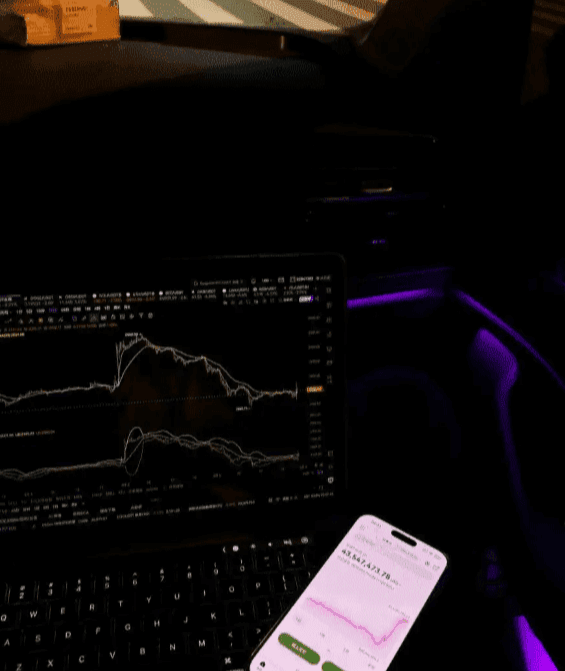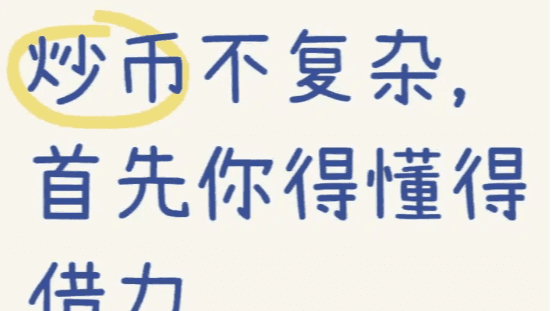After ten years of ups and downs in the cryptocurrency world, I started with an initial capital of 68,000 yuan earned from working and have now accumulated over 40 million in wealth. I focus on spot trading and keep a respectful distance from contracts. Although I haven't achieved billionaire status like some legends starting from ten thousand, I feel deeply satisfied, moving steadily forward, silently hoping that at the end of the year my account can cross the 100 million yuan mark, paving the way for more capital gains next year.
On the journey in the crypto world, maintaining a calm mindset is crucial. In the face of severe market fluctuations, during a drop, I do not let anxiety control my emotions, and during a rise, I do not get lost in temporary euphoria, fully aware that securing profits is the way to safety. Looking back, when I first entered the crypto world, I often lost sleep due to worries, waking up in the middle of the night was a norm. Now, I have learned to treat it with calmness.
Fundamentally, the way to make money involves essential techniques, but what is even more valuable is adhering to one’s own set of principles. Just this belief alone is enough to allow me to surpass many peers, eliminating at least 70% of them!

The most important thing in trading is to choose trend trading. There is a survey conclusion in technical analysis books.
Out of 10 traders, if two are consistently profitable, they are trend traders.
So, for general tasks, when trading, definitely choose trend trading; combined with the previously mentioned trading system, it can absolutely achieve stable profits.
I've already been very straightforward here; it clearly sets the trading rules for newcomers. Even if you are a novice and follow this, if you still cannot profit, then it’s better not to play.
Next, I will share the core strategy of trend trading. This is the essence part, and I can't go into too much detail; I'll leave some good stuff for myself.
The framework of trend trading is as follows:
1. What is a trend, and how do you judge a trend?
Everyone has different standards for judging trends.
Here I’ll briefly share my thoughts.
For example, a breakthrough at the M60 moving average is considered the beginning of a trend.
For example, according to the trend standard definition, a high point is higher than a previous high while a low point is also higher than the previous low.
2. Methods for entering trend trading
Common methods for entering trend trading are two kinds:
One is to enter at support levels, which means entering at pullback positions. The key question is how to judge whether this position is a turning point for the pullback. Common methods include trend line support levels and Fibonacci retracement levels.
Secondly, breaking in is most commonly done by breaking previous highs, and another high-probability method is breaking after a long period of consolidation.
Level up: ponder more on high-probability support and breakout points.

Why is it difficult for 90% of investors to profit?
The core issue is frequently making irrational decisions at the wrong time! Whenever the market corrects, a large number of investors hurriedly sell off like startled birds. If you ask them why they are selling, the answer is often astonishing: 'Everyone is selling, if I don’t sell, I’ll lose big!' This kind of blind following has long deviated from the essence of investment; it is merely a wealth consumption war under collective irrationality.
The fluctuations of the global economy may seem complex and unpredictable, but they actually align with the underlying logic of capital operation. Whether it is geopolitical conflicts, cyclical economic crises, or sudden market panic, history is always remarkably similar, continuously playing out familiar dramas:
The operational cycle of large institutions
Step 1: Create Panic - Institutions concentrate on selling, causing severe market fluctuations
Step 2: Retail Investors Stop Loss - Investors panic and cut losses at the bottom due to fear
Step 3: Accumulating at Low Levels - Institutions calmly take over, completing low-price accumulation of chips
The brutal market truth is:
Professional investors often decisively position themselves during sharp declines
Ordinary investors always chase highs and sell lows
Ultimately leads to wealth flowing from the majority to the minority
True investment wisdom should be:
A market crash is precisely the touchstone for quality assets
Collective panic moments often contain excellent entry opportunities
Most profits are often concentrated in a few key holding phases
Please remember:
In the capital market
Short-term price fluctuations are driven by emotions
Long-term value regression is determined by the fundamentals of the enterprise

The rule of the poor's counterattack: either turn over or accept fate
"Don't play in the crypto world without money? That's bullshit! I entered with 5000 yuan and rolled out with a down payment in three years!"
Those who tell you 'Don't touch cryptocurrency without 100,000' deserve to be vegetables for life. The crypto space is the last chance for ordinary people, and today this 'beggar's version of the get-rich-quick manual' is specifically for curing poverty!
First move: Airdrop exploitation - zero-cost heist on Wall Street
Do you think airdrops are free money? 99% of people can’t even pick up garbage! But I made 30,000 dollars last year using this 'matrix bombing method', cost? 500 yuan!
Airdrop golden rules
Only engage with the top 50 new projects by market cap (wasting time on shitcoins is not as good as sleeping)
Operate 5 wallets simultaneously (500 yuan cost, diversify risks)
Work from 3 to 5 AM (Gas fees are low, almost free)
The first 30 days before the mainnet launch is the golden period (the project party throws money most crazily)
Second move: Contract survival skills - either eat meat or eat dirt
100x leverage is for martyrs! For the poor playing contracts, staying alive is more important than getting rich!
My Contract Iron Rules
Invest 2000 in 5 batches, only trade key breakout points for BTC/ETH
5x leverage (even if it blows up, it won't hurt too much)
Cut losses at 3% (60 yuan for a lesson)
Run after making 5% (monthly average 30% profit is great)
Buddhist faction: 3000 yuan at 3x to stock coins, automatically stop loss if it breaks support
Gambler's Package: Leave 500 yuan for the lottery
Going to zero? Just consider it a donation to the exchange! But what if I hit a hundredfold coin? (laughs)
Bitter lessons
Don't touch altcoin contracts (poor liquidity, guaranteed death by spike)
Don't hold on to losing positions (90% of liquidations are due to 'just wait a little longer')
Don’t play when the Federal Reserve is making noise (the volatility is too high, easy to die suddenly)
My three no principles for shitcoins
Don't touch coins that have not been audited (99% are scam projects)
Don't engage with Telegram groups that have no real people (projects full of bots = scams)
Don't touch coins with a market cap exceeding 100 million (limited room for growth)
The ultimate mindset for the poor to turn over
Seize opportunities that others do not understand (airdrop, shitcoins, early projects)
Use strategies that others dare not use (low-leverage contracts, diversified investments)
Retreat when others are greedy (withdraw principal when it doubles, let profits continue to roll)
Remember: the crypto world does not care how much capital you have, only how clear your mind is. Either enter with a strategy or leave with dignity - at least the casino gives you free drinks, in the crypto world, even tears are expensive.

Today I share this with friends who are still losing in the crypto world and newcomers to the market, hoping it can help you, at least allowing new coiners to avoid ten years of detours. In this field full of opportunities and risks, if you want to walk steadily on the investment road and achieve ideal results, you need to deeply understand various investment strategies and techniques.
1: When preparing to enter the cryptocurrency world for investment, first make ample preparations. It is better to enter with a small amount initially than to blindly rush in. Proceed with caution and fully assess risks and your own capacity.
2: When the coin price is at a low sideways state, and then creates a new low, this is an excellent time to buy heavily. At this point, the market may have already bottomed out, and a significant rebound is expected.
3: When the coin price spikes, you should promptly sell your holdings; when the coin price crashes, you should decisively enter the market. During sideways phases, try to avoid trading, as the direction is unclear and risks are high.
4: If the coin price remains in a sideways state for a long time, it often means that it may be replacing a decline with consolidation. At this time, hold onto your coins tightly because a surge may occur at any moment.
5: When the coin price experiences rapid surges, always be ready to sell, as such rapid increases are often accompanied by sudden drops.
6: When the coin price is slowly declining, it is a good time to gradually add to your position, which can lower the average cost.
7: When facing high and low consolidations, first be patient and wait; this is one of the secrets of trading. Do not rush to act to avoid unnecessary losses.
8: When the coin price consolidates at a high and then spikes again, seize this opportunity to sell quickly and secure profits. When the coin price is consolidating at a low and then creates a new low, you should buy in fully; this is a rare good opportunity.
9: If the coin price does not spike, do not sell; if the coin price does not crash, do not buy. During sideways periods, do not trade. Adhering to this principle can avoid many unnecessary risks.
10: Choose to buy on bearish candles rather than bullish ones; sell on bullish candles rather than bearish ones. Moving against the conventional market thinking is the mark of a true investment hero. If the coin price rises significantly in the morning, you should sell; if it rises in the afternoon, don’t blindly chase; if it drops significantly in the afternoon, consider buying the next day; if it drops in the morning, don’t rush to cut losses. In cryptocurrency investment, maintaining calm and rationality, following these principles and strategies helps you better cope with market fluctuations and achieve investment goals.
The above ten iron rules are also summarized from my personal experience, hoping to help those who are still losing in the cryptocurrency market and new coiners.

